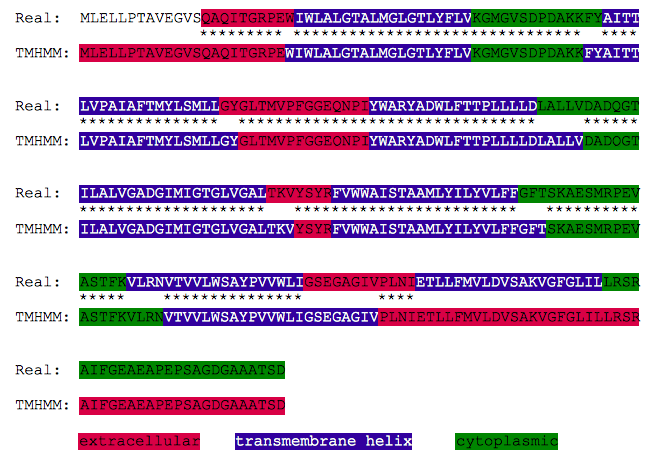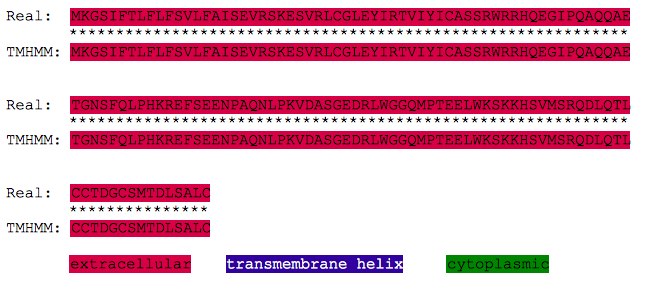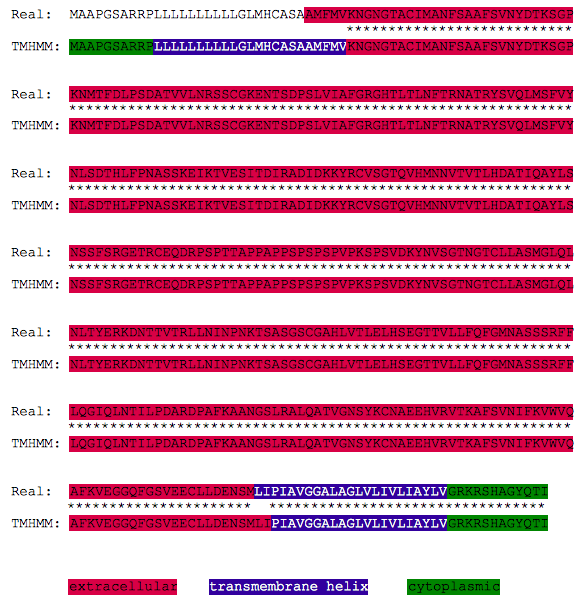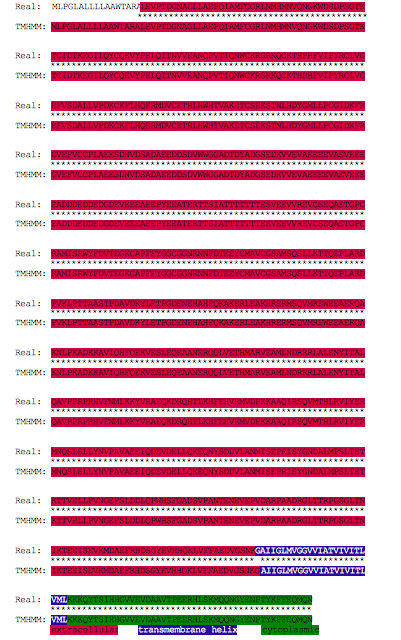Sequence-based predictions HEXA
Contents
General Information
Secondary Structure Prediction
Prediction of disordered regions
- DISOPRED
Authors: Ward JJ, Sodhi JS, McGuffin LJ, Buxton BF, Jones DT.
Year: 2004
Source: [Prediction and functional analysis of native disorder in proteins from the three kingdoms of life.]
Description:
This method is based on a neuronal network which was trained on high resolution X-ray structures from PDB. Disordered regions are regions, which appears in the sequence record, but their electrons are missing from electronic density map. This approach can also failed, because missing electrons can also arise because of the cristallization process. The method runs first a PsiBlast search against a filtered sequence database. Next, a profile for each residue is calculated and classified by using the trained neuronal network.
Prediction:
As a prediction result you get a file with the predicted disordered region, the precision and recall. Furthermore you can a more detailed output. There you see the sequence, and the predictions and also numbers above the sequence (from 0 to 9 which shows you how likly your prediction is)
Input:
If you run disopred on the console, you have to define the location of your database. The program needs as input your sequence in a file with fasta format.
- POODLE
Prediction of order and disorder by machine-learning
Authors: S. Hirose, K. Shimizu, S. Kanai, Y. Kuroda and T. Noguchi
Year: 2007
There exist three different variants of POODLE.
The first variant is called POODLE-L which predicts mainly long disorder region with a length more than 40.
Source: [POODLE-L: a two-level SVM prediction system for reliably predicting long disordered regions.]
The next variant is called POODLE-S, which predicts mainly short disorder regions.
The last variant is called POODLE-I, which integrates structal information predictors.
There exists als another variant called POODLE-W, which compares different sequences and predicts which sequence is the most disordered one, but this method wasn't used in our analysis.
Description:
POODLE is also a machine learning based method. This method based on a 2-level SVM (Support Vector Machine).
We describe here the POODLE-L in detail, but all POODLE variants use the same principle. The method was trained on disordered proteins and proteins with no disoredered regions. On the first level, the SVM predicts the probability of a 40-residue sequence segment to be disordered. If the algorithm found such a disordered regions, the second level of the SVM use the output from the first level and predicts the probability to be disordered for each amino acid.
Output:
The result of this method is a file with the single amino acids, the prediction if it is ordered or not and the probability for the state. Furtheremore, you get a graphical view of the result.
Input:
We used the POODLE webserver for our analysis. We paste our sequence in fasta format in the input window and chose the POODLE variant.
Prediction of transmembrane helices and signal peptides
- TMHMM (transmembrane helices hidden markov model)
Authors: E. L.L. Sonnhammer, G. von Heijne, and A. Krogh
Year: 1998
Source: A hidden Markov model for predicting transmembrane helices in protein sequences.
Description:
TMHMM is a hidden markov model-based prediction methode for transmembrane helices in proteins. The HMM consists of three different main locations (core, cap, loop) and seven different states (cytoplasmic loop, cytoplasmic cap, helix core, non-cytoplasmic cap, short non-cytoplasmic loop, long non-cytoplasmic loop and globular domain).
Prediction:
This method search for a given protein sequence in FASTA-format the best path through the hidden markov model. There are two output possibilities, the short one and the long one. The long output format gives additional statistic information (i.e. expected numbers of amino acids in transmembrane helices).
Input:
The method only needs the protein sequence in FASTA-format for the prediction.
Prediction of GO Terms
Secondary Structure prediction
Prediction of disordered regions
Before we start to analyse the results of the different methods, we checked, if our protein has one or more disoredered regions. Therefore, we search our protein in the DisProt database and didn't found it, so our protein doesn't have disordered regions. Another possibility to find out if the protein has disordered regions, is only to check in the UniProt entry, if there is an entry for DisProt.
- Disopred
Disopred predicts two disordered regions in our protein. The first region is at the beginning of the protein (first two residues) and the second region is at the end (last three regions). This prediction is wrong, because it is normal, that the electrons from the first and the last amino acids lack in the electron density map. So, our protein Hexosamidase A has no disordered regions.
- POODLE
We decided to test several POODLE variants and to compare the results.
POODLE-I
POODLE-I predicted five disordered regions:
| start position | end position | length |
| 1 | 2 | 2 |
| 14 | 19 | 6 |
| 83 | 89 | 7 |
| 105 | 109 | 5 |
| 527 | 529 | 3 |
POODLE-L
POODLE-L found no disordered regions. Therefore, there is no disordered region with a length more than 40aa in our protein.
POODLE-S (High B-factor residues)
This POODLE-S variant searches for high B-facto values in the crystallography, which implies uncertainty in the assignment of the atom positions.
POODLE-S predicted five disordered regions:
| start position | end position | length |
| 0 | 2 | 2 |
| 13 | 19 | 7 |
| 83 | 88 | 6 |
| 105 | 109 | 5 |
| 526 | 529 | 4 |
POODLE-S (missing residues)
POODLE-S (missing residues) predicts regions as disordered, if there is a amino acid in the sequence record, but not on the electron density map.
Poodle-S found 6 disordered regions.
| start position | end position | length |
| 17 | 18 | 2 |
| 53 | 61 | 9 |
| 78 | 109 | 33 |
| 153 | 153 | 1 |
| 280 | 280 | 1 |
| 345 | 345 | 1 |
Graphical Output:
Comparison of the different POODLE variants: POODLE-L doesn't find any disordered regions. This is the result we expected, because our protein doesn't posses any disordered regions.
Both POODLE-S variants found several short disordered regions, which is a false result. Interesstingly, there seems to be more missing electrons in the electron density map, than residues with high B-factor value.
POODLE-I found the same result as POODLE-S with high B-factor, which was expected, because POODLE-I combines POODLE-L and POODLE-S (high B-factor).
Therefore, the predictions of short disordered regions are wrong results. Only the prediction of POODLE-L is correct.
In general, these predictions are used, if nothing else is available about the protein. Therefore, normally we don't know, that the prediction is wrong. Because of that, we want to trust the result and we want to check if the disordered regions overlap with the functionally important residues, because it seems that disordered regions are functionally very important. We check this for POODLE-S with missing residues and POODLE-I, because POODLE-S with high B-factor values show the same result als POODLE-I.
| functional residues | disordered | |||
|---|---|---|---|---|
| residue position | amino acid | function | POODLE-S (missing) | POODLE-I |
| 323 | E | active site | ordered | ordered |
| 115 | N | Glycolysation | ordered | ordered |
| 157 | N | Glycolysation | ordered | ordered |
| 259 | N | Glycolysation | ordered | ordered |
| 58 (connected with 104) | C | Disulfide bond | disordered | ordered |
| 104 (connected with 58) | C | Disulfide bond | disordered | ordered |
| 277 (connected with 328) | C | Disulfide bond | ordered | ordered |
| 328 (connected with 277) | C | Disulfide bond | ordered | ordered |
| 505 (connected with 522) | C | Disulfide bond | ordered | ordered |
| 522 (connected with 505) | C | Disulfide bond | ordered | ordered |
As you can see in the table above, only on disulfide bond is located in a disordered region, all other functionally important residues are located in ordered regions. This is a further good hint, that the predictions are wrong.
Prediction of transmembrane alpha-helices and signal peptides
Because most of the proteins we used in this practicum aren't membrane proteins, we got five additional proteins for the transmembrane and signal peptides analyses.
Additional proteins:
| name | organism | location | transmembrane protein | sequence |
| BACR_HALSA | Halobacterium salinarium (Archaea) | Cell membrane | Multi-pass membrane protein | [P02945.fasta] |
| RET4_HUMAN | Human (Homo sapiens) | extracellular space | No | [P02753.fasta] |
| INSL5_HUMAN | Human (Homo sapiens) | extracellular region | No | [Q9Y5Q6.fasta] |
| LAMP1_HUMAN | Human (Homo sapiens) | Cell membrane | Single-pass membrane protein | [P11279.fasta] |
| A4_HUMAN | Human (Homo sapiens) | Cell membrane | Single-pass membrane protein | [P05067.fasta] |
TMHMM
We analysed the six sequences with TMHMM.
- Hexosamidase A
TODO
- BACR_HALSA
| start position | end position | location |
| 1 | 22 | outside |
| 23 | 42 | TM Helix |
| 43 | 54 | inside |
| 55 | 77 | TM Helix |
| 78 | 91 | outside |
| 92 | 114 | TM Helix |
| 115 | 120 | inside |
| 121 | 143 | TM Helix |
| 144 | 147 | outside |
| 148 | 170 | TM Helix |
| 171 | 189 | inside |
| 190 | 212 | TM Helix |
| 213 | 262 | outside |
TMHMM predicts six transmembrane helices for BACR_HALSA. We decided to compare the TMHMM prediction with the real occuring transmembrane helices in BACR_HALSA:
Especially in the beginning is the prediction really very good. There is almost 100% overlap between predicted and real helices. Only in the end of the protein lacks one transmembrane helix in the TMHMM prediction. Therefore, in real there are 7 transmembrane helices, whereas TMHMM only predicts 6. This is really bad, because it is a different for the function if there are 6 or 7 helices, but in general the prediction of TMHMM was quite good.
- RET4_HUMAN
| start position | end position | location |
| 1 | 201 | outside |
TMHMM predicts no transmembrane helices. The whole protein is loacted in the extracellular space.
The TMHMM prediction is completly right. Therefore, you can see TMHMM can also predict, that a protein is not a transmembrane protein.
- INSL5_HUMAN
| start position | end position | location |
| 1 | 135 | outside |
TMHMM predicts no transmembrane helices. The whole protein is loacted in the extracellular space.
The TMHMM prediction is again completly right.
- LAMP1_HUMAN
| start position | end position | location |
| 1 | 10 | inside |
| 11 | 33 | TM Helix |
| 34 | 383 | outside |
| 384 | 406 | TM Helix |
| 407 | 417 | inside |
TMHMM predicts two transmembrane helices, which are divided by a very long loop which is loacted at the extracellular space.
The prediction of TMHMM is quite good. Only at the beginning of the protein TMHMM predicts one wrong transmembrane helix, but the rest of the prediction is correct.
- A4_HUMAN
| start position | end position | location |
| 1 | 700 | outside |
| 701 | 723 | TM Helix |
| 724 | 770 | inside |
TMHMM predicts on transmembrane helix at the end of the protein. As we already know is A4_HUMAN a single-spanning transmembrane protein and therefore the numbers of transmembrane helices is right predicted. As next step we compared the position of the transmembrane helix.
The result of the TMHMM prediction is pretty well. Except of the first residues at the beginning and the exact start position of the transmembrane helix, the prediction is correct.














